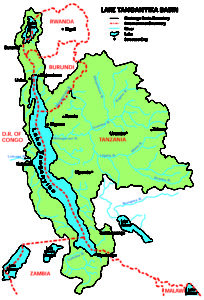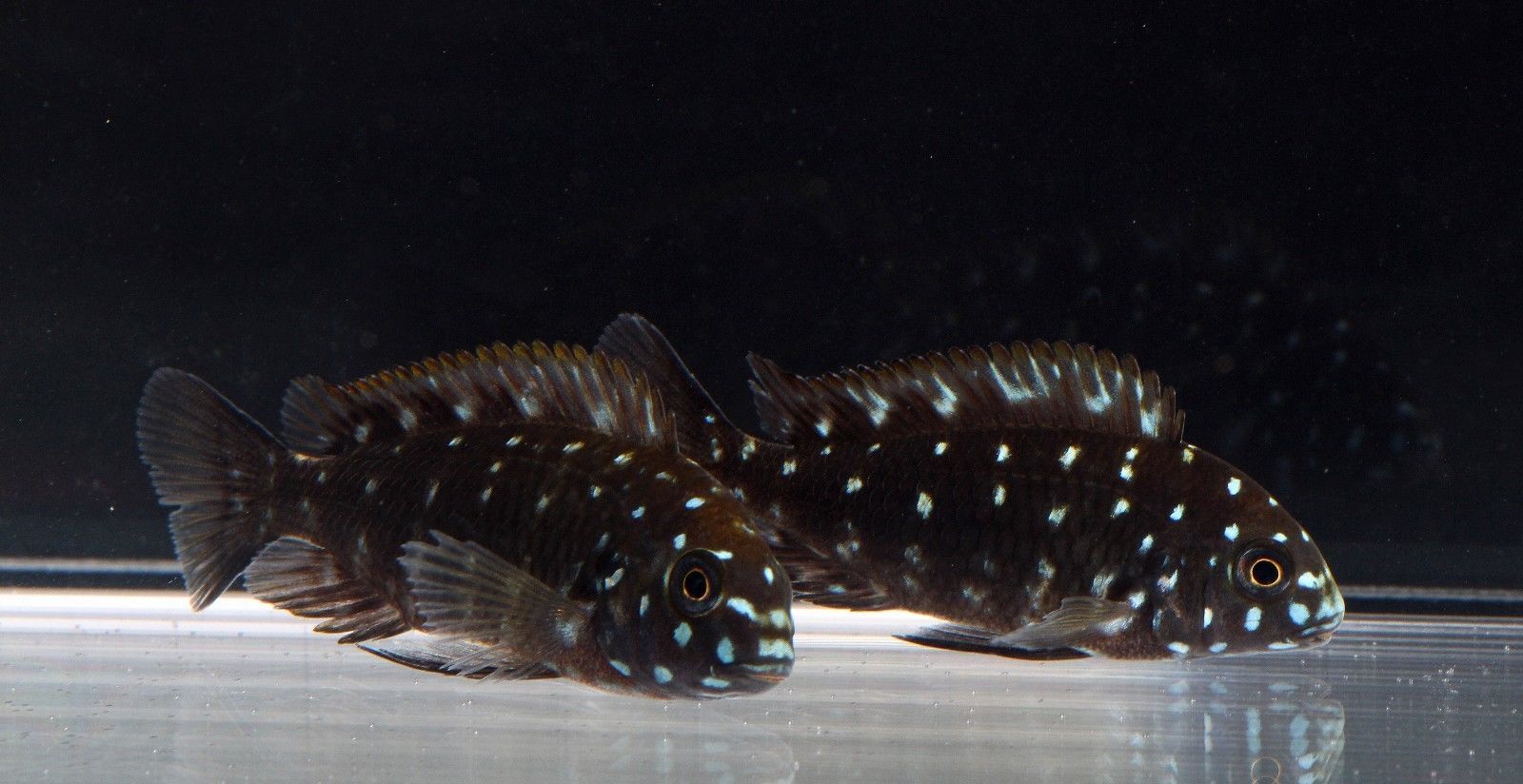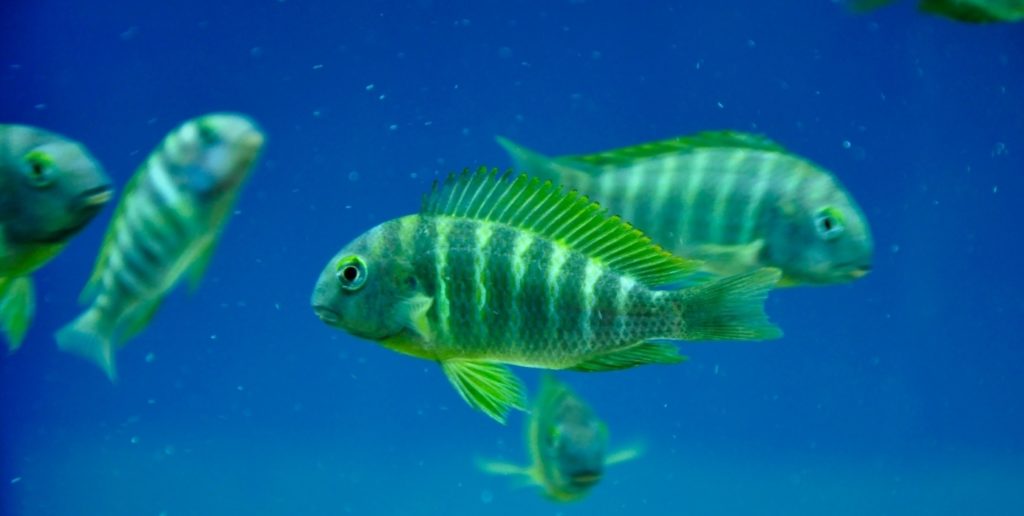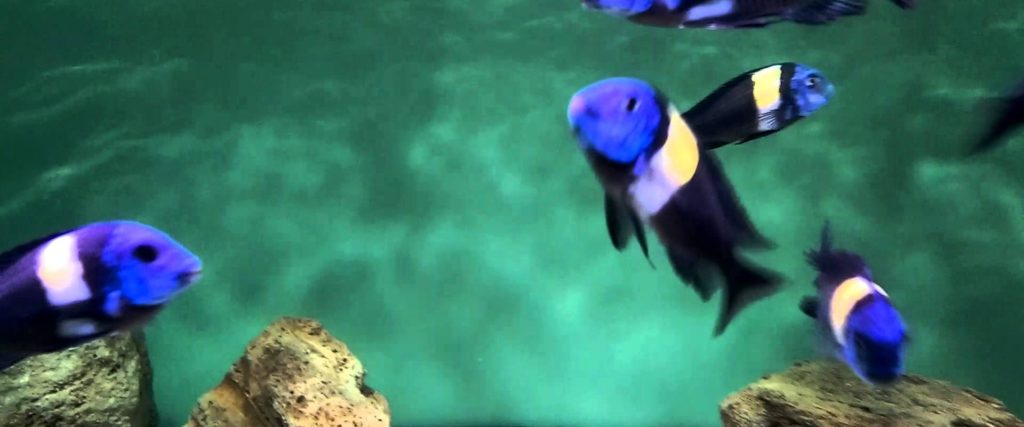Meet today the White spotted cichlids or Tropheus duboisis, which are very popular fish in many aquariums, although their care is not very easy.
Table Of Content
Taxonomy:
Kingdom: Animalia Phylum: Chordata Class: Actinopterygii Order: Perciformes Family: Cichlidae Genus: Tropheus
Brief Review of Tropheus Genus:
This genus belongs to the Cichlidae family and the perciformes order. It is endemic to Lake Tanganyika in Eastern Africa from Burundi to Zambia.
Species
- Tropheus annectens
- Tropheus Brichardi
- Tropheus Duboisi
- Tropheus Moorii
- Tropheus kasabae
- Tropheus Polli
Lake Tanganyika contains many endemic cichlids that are very popular for most African cichilds fan. . The most popular without any doubt are those belonging to the genus Tropheus. However, maintaining these stunning fish in aquariums is not easy due to their territorial behavior and nutritional needs.
Cichlidae Family
All cichlids share a common characteristic of some saltwater fish: they have a well-developed pharyngeal set of teeth located in the throat along with their regular teeth. The adults have a blue-to-blue-gray head, with a spot usually dark, while the body and fins are almost black.
Cichlids are species of a huge evolutionary success (mostly freshwater) that are very attractive for domestic fish-tanks, being the most requested fish by aquariums lovers. Every year are discovered many new species not described yet.
The actual number of species in this family is not clear, with estimations ranging from 1300 to 3000 species, that have a great diversity of shapes and unique characteristics, which make this one of the largest families of vertebrates. Most of the species in this family have an average life of 10 to 20 years. Let’s learn now about our today’s cichild species.
Let’s learn now about our today’s cichild species.
White Spotted Cichlids’ Main Characteristics
One of the white spotted cichlids most striking features is the color transformation they go through as they grow, since juvenile specimens are totally different from the adult ones.
Anatomy
These sturdy fish have a large head compared to their body which gets smaller on the tail. Adults have blue or bluish-gray heads. The rest of the body is mostly black with some blue flash and a very contrasting band (yellow or white) in the middle of the body.
Young specimens have a beautiful color pattern, which consists of a matt black body with many points that go from blue to white sky. Such a body color remains for almost a year which makes them be sometimes called «The Pearly Butterfly». We invite you to read our article the anatomy of fish to learn more about such a topic.
Sexual Dimorphism:
There isn’t a big sexual dimorphism in white spotted cichlids. There are only small differences, related to the growth rate and the body’s shape. Males grow somewhat faster and with a slightly more intense coloration.
They also have the upper lip somewhat larger and the nose a little more upward. However, the best way to determine them for an expert is the genital papillae, which in the females is rounded and in the males more pointed.
Other Traits
White spotted cichlids are mouth brooders, (oral incubators) of not excessive-aggressive behavior. They live in relatively deep waters of scarce food. That’s why they spend much of the day wandering from one rock formation to another.
Size
Up to 12 cm.
wake up
White Spotted Cichlids’ Habitat and Distribution
All specie s of thropeus inhabit shallow waters, not beyond 20 meters deep, the top being the maximum distance to which light can penetrate and therefore enable the appearance of algae from which they feed. They live in family groups sheltered from rocky constructions or boulders of which they never venture to leave.
s of thropeus inhabit shallow waters, not beyond 20 meters deep, the top being the maximum distance to which light can penetrate and therefore enable the appearance of algae from which they feed. They live in family groups sheltered from rocky constructions or boulders of which they never venture to leave.
The smallest species, (in this case the T. Duboisi), are found deeper than their congeners due to the competition of other species for territory and food, with which they aren’t able to compete because of their smaller size.
In addition, if we look carefully at the mouth shape of the species that are at greater depths, we will discover that they are not as downward oriented as that of more superficial species, since they are less exposed to the force of the waves and to the attacks of competing species or predators.
Although they are extremely belligerent they coexist in large communities as long as that the amount of food is sufficient for all of them.
The habitat consists mainly of rocky areas near the shores of the lake and sometimes in intermediate areas. They are found at a depth of between 5 and 25 meters.
Distribution:
Lake Tanganyika
Tropheus duboisi «kigoma»
This is the largest subpopulation, which inhabits in an area of around 100 km along the coast between Tanzania and Burundi, which is south of Nyanza Lac, up to the Malagarasi river.
Tropheus duboisi «bemba»
This subpopulation is also known as Wideband Duboisi in English. It is located in a small area of just over 1 km long around Cape Munene, where used to be located the extinct town of Bemba,.
Tropheus duboisi «Maswa» or Tropheus duboisi «Malagarazi»
This subpopulation is also known as Broad Band Duboisi or Wide Yellow Band. It develops around the delta of the Malagarazi river, but its full range is not yet determined.
let’s watch
Getting a Tropheus Duboisi
The Tropheus Duboisis are commonly available online or in fish shops. These really striking and coveted cichlids are relatively expensive, and the price depends on the provider the adults being generally more expensive. Be sure to examine them if they have spinal defects before purchase.
For more success in your aquarium buy between 12 to 15 fry and let them grow together. If you buy adults you should only make sure that it’s an established group of at least ten adult members with one male included.
Aquarium:
200 liters is the minimum capacity recommended for these fish. It should have enough rocky structures, that form caves, caverns and all kinds of hiding places that serve for the females harassed by the males. It’s also important to have sandy areas to separate the rocky ones as well as free space for swimming.
In addition, plants are another excellent option, but it should be remembered that white spotted cichlids are very vegetarian fish, that won’t hesitate to the possibility of nibbling on tender plants.
The aquarium must have a good water movement along with a very strong and efficient filtration. Regularly check nitrate and PH. Nitrates shouldn’t be more than 25 ppm and a PH less than 7 is not tolerated. In addition, check for total hardness and carbonate hardness, avoid overfeeding and excess fish in the tank. White spotted cichlids also need iodine, which helps their thyroid to function properly.
Feeding White Spotted Cichlids in Aquriums
This is an omnivorous species, but much of its diet consists of herbivorous foods. In nature white spotted cichlids usually feed on the hard filamentous algae attached to the rocks together with the microorganisms they contain. In captivity they must be fed with scales and granules based on spirulina. It’s suggested the use of spinach or romaine lettuce at least once a day, as well as pellets and small amounts of live food and/ or protein supplements.
Behavior:
Among all the species belonging to the Tropheus genus, the duboisi is the one of most peaceful temperament. Although all Tropheus need to be kept in colonies, this trait allows the group to be smaller than in the case of the rest of their cousins. In any case, if there is more than one male in the group, it’s possible that there will be confrontations, which is why your fish-tank capacity must be the previously mentioned.
White spotted cichlids have a long intestinal tract and shouldn’t be fed excessively, since overfeeding can contribute to bloating. Feed them 3 times a day with small pieces of food instead of a large amount once a day. This will keep the water quality high for a longer period of time.
Let`s watch them
How Do White Spotted Cichlids Reproduce?
It is suggested to enter nine females or more for each male, the more males you want to have more females you must join the aquarium to create a healthy group. You must also have a pond of around 75 gallons for a harem of ten to twelve juvenile fish.
For a larger group of about fifteen to twenty juveniles, you must have an aquarium of 125 gallons make up the harem.
The females could be tricky to get in reproductive conditions, while males will always be ready to procreate and are constantly trying to persuade the females to spawn, whether they are ready or not. The female carries her fertilized eggs in the mouth, being commonly necessary to remove them from the aquarium while doing so, preventing this way the male from harassing her.
If kept in the same tank with the male, experienced breeders suggest hanging four or five pieces of PVC pipe on the edge of the tank with monofilament to protect the melancholic females.
When the female releases the eggs from her mouth, the fry will be healthy and ready to feed, this happens because they are quite large when they are born.
The sex of the fish is difficult to determine, there are some small differences in the rate of growth and body shape. For example, males tend to be a little larger than females and may have a deeper body, a more prominent upper lip and a more upward nose. The females don’t grow as fast as the males and their coloration is less audacious. However, the best method is to examine their genital papillae, which is pointed in the male and rounded in the female.
let’s watch and learn
Common Illness in White Spotted Cichilds
These striking creatures are relatively resistant as long as diligent attention is paid to maintaining their environment and diet. These fish are susceptible to typical fish diseases, especially if the water is rancid, of low quality and low oxygenation. An ounce of prevention is worth a pound of cure. If you change water, don’t overfeed them, and provide adequate hiding places.
Ich’s disease
Even taking all the necessary care white spotted cichilds can sometimes get sick. A common problem is Ich, which can be treated by raising the tank’s temperature to 30 ° C for 3 days. Several copper-based drugs areavailable for Ich’s disease. The use of copper should be kept within the appropriate levels, so be sure to follow the suggestions on the label. You can also combine the increase in temperature with a medication treatment for the Ich. A copper test can also be used to maintain adequate levels.
Let’s watch and learn
Dropsy
The species of Tropheus Duboisi are very susceptible to Dropsy, Although it’s not certain what this disease is, it is generally believed to be caused by a protozoan parasite complicated by a bacterial infection. The most common cause of Dropsy is stress and the first sign of the disease is that the fish is not eating.
Stress can be caused by things such as transportation, networks, poor water quality, insufficient diet, overfeeding and lack of hiding places. Other causes are an inadequate diet and adding too much salt to the water. The first sign of this disease as indicated above is the loss of appetite, which is followed by abdominal swelling, difficulty for breathing, apathy, isolation, possible red striae in the body and fibrous white stools.
A fish that is not eating should be treated immediately or it can get complicated quickly, the disease become incurable and the fish die. Prevention is quite import and it’s possible to cure a fish if it is treated immediately. The following are some of the techniques used by aquarium specialists:
- Any new individual you get may swell and develop the disease soon, so when you buy a fish for the first time, try to provide them with the same food the distributor used to feed them, and then you can wean them with a diet based on vegetables, spirulina, scales and pellets.
- A healthy group of fish will eat with pleasure. But even though they can eat very actively it’s important not to overfeed them. Watch them and if one is not eating vigorously you can treat the aquarium with Clout.
- If you notice that a fish is not eating properly you should segregate the fish, which may be sick. Once isolated you must change waterduring five consecutive days in the main aquarium. Metronidazole is considered the most reliable cure and Clout as another cure is also very good but you should never use them together.
Let’s watch and learn









